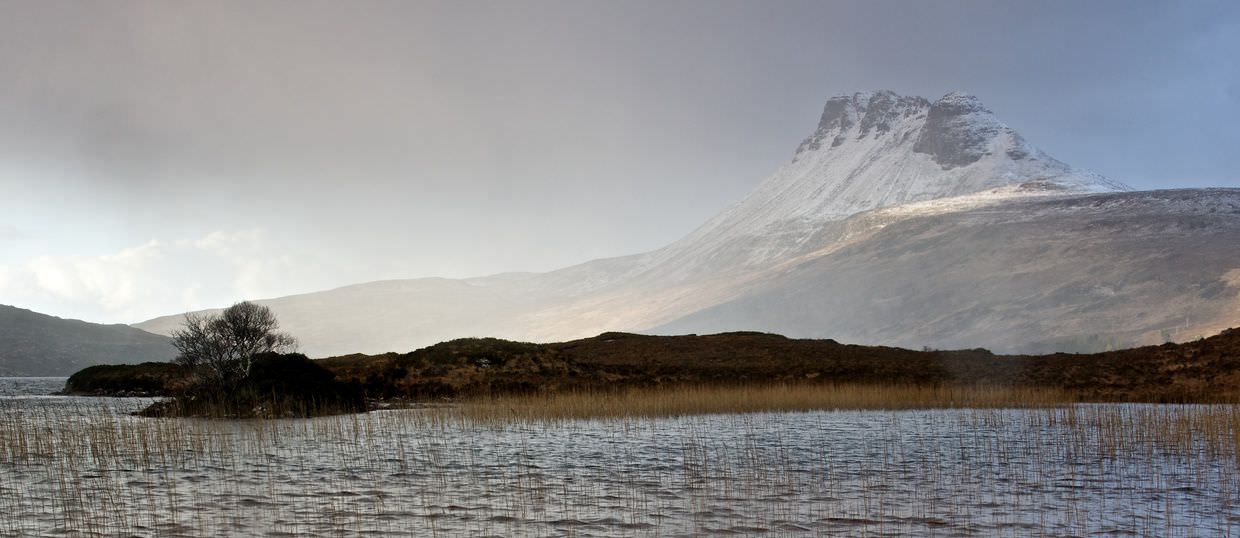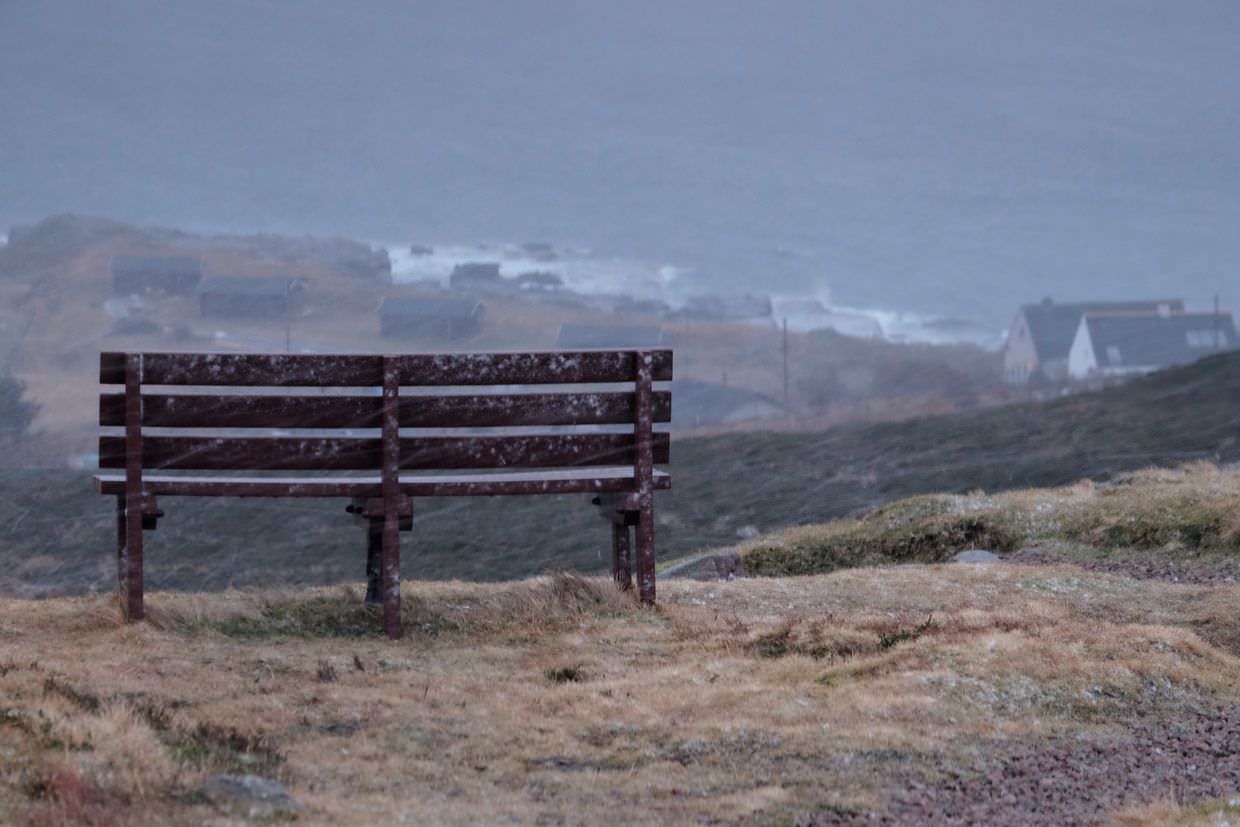Photography lessons with Ian Cameron in Ullapool and Inverpolly
Two days of photography with Ian Cameron
After a proper Scottish breakfast (porridge, smoked haddock, not together), our guide and photography tutor for the weekend, Ian Cameron, picked us up from from our hotel and we embarked on our wintery journey across the North West of Scotland. Ian is an award winning landscape photographer who consistently produces the finest images, often of Scotland‘s most impressive mountains and lochs; he’s also quite lovely. Through his company Transient Light he sells prints, runs workshops and has authored a book aimed at amateurs seeking to become professional. Ian shoots medium format 6x7” film (10 shots per roll) on his Pentax 6x7ll, and occasionally digitally using a Fuji XT-1. This unusual 6x7 format combined with a style that captures the most exquisite, fragile and fleeting light, makes his images instantly recognisable. Sam had found Ian online, and arranged for a two-day private workshop based near the remote town of Ullapool in Ross-shire, where we were headed now.
Waterfalls
From Inverness we took the A835, passing Ben Wyvis and Loch Glascarnoch, often cited as the coldest place in Britain. The car’s weather gauge read -11C and all about us was white with snow. As we neared Ullapool and the West coast it grew a little warmer. Ian pointed out the leafless Birch trees, that appear red from a distance, but up close always look grey. At the tail end of Loch Broom we stopped near a crooked waterfall for our first lesson.
We’d brought a lot of camera gear with us. Sam had simply said: “we need all the photography stuff we have”. Most of it we didn’t use. We quickly ditched our Manfrotto travel tripod for one of Ian’s heavy duty “set it and leave it” Gitzo 3530LS tripods, with a precise Really Right Stuff BH-55 QR ballhead. On top of these we used our Canon 70D and Canon 500D cameras, each with a wide angle lens; a recently bought EF 17-40mm f/4L USM, and a EF-S 17-55mm f/2.8 IS USM. The heavy tripods were hard to use at first, intentionally stiff and sturdy, it was difficult to setup, though we were soon very happy with them.
Ian began with the basics, teaching us the different ways of photographing a waterfall and using that as a means of us learning how to balance shutter speed, ISO and aperture. Moving water can be captured in three distinct ways; staccato – where the water droplets form short lengths usually at a shutter speed of 0.3s or faster; stringy – where the lengths grow longer and form a continuous line from one point of interest to another at shutter speeds of 0.5s to 0.6s; and misty or foggy – where all motion is obscured and the water becomes a blur with light and dark patches. Stringy is often the most desired outcome, as it smoothes out the rough edges while persisting a sense of motion.

Left: misty, middle: stringy, right: staccato

Here there were also many “macro landscapes” as Ian referred to them. Endless textures, repeating patterns and compositions amongst the slippery rocks and undergrowth. But a mildly heavy snow drift pushed us back to the car, and we continued on to Ullapool to grab some lunch from Tesco. The afternoon saw us go North from Ullapool, along the A835 again, up to Loch Lurgainn and Stac Pollaidh mountain, for our first “big landscape” tutorial.
Stac Pollaidh and filters
Parking the car in a lay-by we hopped the metal barriers and squelched down a small hill to the loch’s edge, cameras at the ready, tripods in hand, boots inch deep in mud. “Always approach the scene from behind”, Ian warned, the last thing we wanted was a string of footprints in the otherwise pristine sand. On the journey here the sun was breaking through the fast moving clouds, occasionally smattering the white mountaintops in bright yellow light.
With water, a bright sky and dark land, we needed to use filters to balance the exposure and “brighten the land”. Ian provided us with mounts and 77mm adapters as part of a Hitech filter system. We used custom 0.45 (1.5 stop) hard edged filters. Before trying out these filters I’d presumed a soft-edge grad would be better, and I’d have made the mistake of buying many varieties of them. Ian explained that with a softer edge you’ll be pushed to get the right exposure where the land meets the sky, and it’s especially bad around sunset where there’s a hard and dark horizontal line that needs balancing. The trick is to find a horizontal line that goes through the frame where the filter can sit, hiding the exposure line from view. Actually lining up the filter was trickier than expected, the exposure balance in live-view obscures the line; instead Ian recommended we use the depth of field preview (a button beneath the lens barrel) and move the filter while looking through the viewfinder. 0.45 was a good density to use to balance the sky and water, anything more than that would leave the water unnaturally bright. Though if there was no water we could have tried a 0.6 (2 stop) filter. I tried out some long exposure shots too, using an 8 stop ND filter which cast a slightly cyan hue.
Alongside a little crescent beach we searched for our compositions. Ian explained that he tries to give his images a sense of place, if the picture is cold, then the viewer should feel the cold, they should almost be able to step into the image and be there – the picture must trigger the imagination to fill in the gaps – the sounds, the smells, the conditions; a really good photo can do all this. Our foregrounds needed a focal point that could nicely lead into the vast mountain scene ahead of us. This would give the image depth. I used a small rock on the water’s edge, ahead of a reed bed and focussed approximately one third of the way away from it. Then we waited for the light to return.
The weather was changeable, and the clouds moved swiftly. The light dazzled us in all its luminous forms; from light reflecting off heavy snowy clouds, or lighter fluffy ones, the scene changed from yellow hues, through red ones and blue ones. At times the snow peaked mountain looked cold and blue, then the reds of the bank appeared through the lightly sprinkled snow, then a warm yellow; and this was all without direct sunlight hitting the mountain. It was a perfect introduction to luminous light and how to spot it or anticipate it. The water too followed interesting patterns, changing from “dead light” looking in one direction, where there was no discernible detail or colour, to luminous in the other, glowing red, blue or yellow. We kept shooting, but also kept waiting for the right conditions to appear, occasionally sheltering from the passing snow drifts that we could spot coming through (“don’t worry, snow bounces off”). And before we’d realised, almost two hours had passed.
Examples of different lighting



A gap in the clouds lit up the snowy peak in a dazzling yellow, some clouds created a shadowy middle, and then the reeds lit up too, and that’s what we’d been waiting for. And then as quickly as it had appeared it was gone again, and now the sun was too low behind the mountains for it to re-emerge. We settled for that and returned to the car to warm up with a lovely cup of tea.


Sunset and snow over Altandhu
From Stac Pollaidh Ian drove us towards the coast, along roads with suicidal sheep and deer, and a group of devilishly difficult to see black sheep. We passed by the Brae of Achnahaird and watched the light do magnificent and peculiar things over the sea; the deep clouds above were turning red in the evening light, while a very strong turquoise hue lit up the nearby sea, contrasting the sea further back which was a deep blue.
We stopped near a mound that offered a view over a collection of small islands looking West. If we were lucky the sun might peek through and we’d have something a little bit special. Up on the mound the wind was blowing a gale, and we sheltered behind a stone placard while we waited. For a brief moment red beams of light materialised, before a mini blizzard swept us up and all visibility disappeared. And that was that.

The Royal Hotel Ullapool
It took a couple of hours to get back to Ullapool, where we checked in to The Royal Hotel. With it being a Sunday night in the middle of January, the place was empty and we were upgraded to the hotel’s best room, which comes with a panoramic view of the loch and a four poster bed. Though it was already dark and we were leaving before dawn, so the view wasn’t much good to us.
Over dinner, Ian, Samantha and I shared talk of sports, life and photography before settling in for the night. Tomorrow was an early start, and the forecast said it’d be much colder. Good job The Royal were packing us a bacon buttie breakfast!
